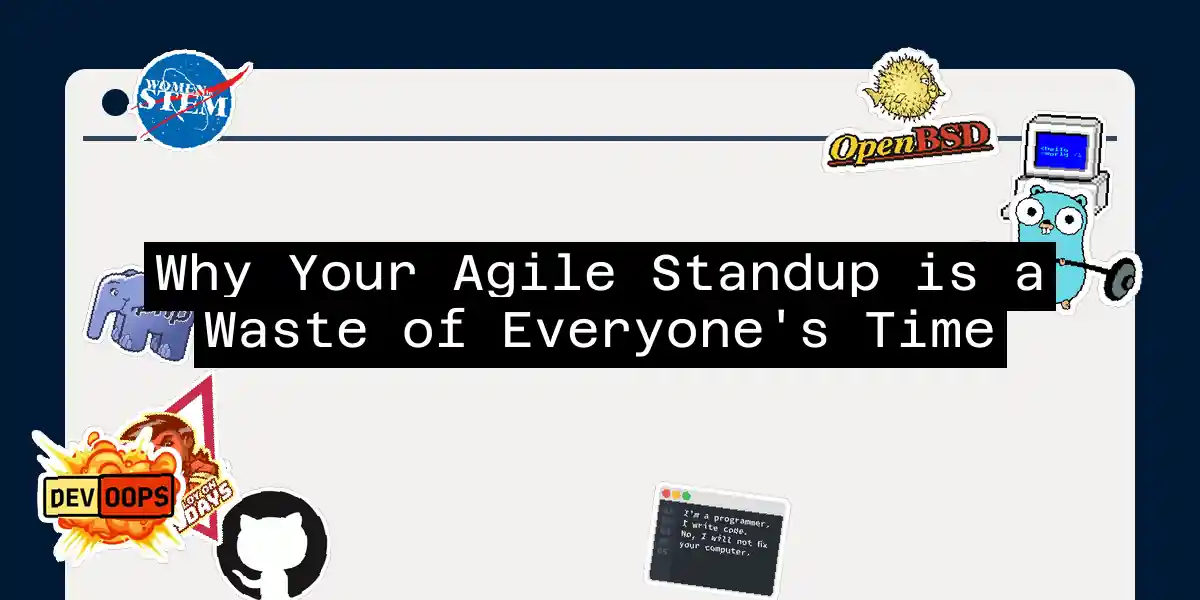The Daily Standup: A Necessary Evil or a Productivity Killer?
In the world of software development, the daily standup is a staple of Agile methodology. It’s meant to be a quick, 15-minute pulse-check where team members update each other on their progress, plans, and any impediments. But let’s face it, many of us have been there—sitting through a standup that feels more like a chore than a valuable team-building exercise. So, why do these meetings often feel like a waste of time?
The Problem with Irrelevant Updates
Imagine you’re part of a six-person team, and each member has to give an update. Sounds simple, right? But what if each update is about tasks that are completely unrelated to your own work? You start to tune out, and before you know it, you’re mentally checking out and waiting for the meeting to end.
This diagram illustrates the typical flow of a daily standup, but it doesn’t show the mental disengagement that occurs when updates are irrelevant. If you’re not working on related tasks, why should you care about someone else’s progress? It’s like listening to a neighbor’s gardening tips when you’re trying to fix your car.
The Silo Effect
Sometimes, the problem isn’t the standup itself but the way the team is structured. If team members are working in silos, each on their own user stories or features without any overlap, the standup becomes a series of disconnected updates. This isn’t a team; it’s a group of individuals working independently.
To fix this, you need to break down the silos. Ensure that everyone is working towards a common goal and that tasks are aligned with the team’s objectives. This might involve regrouping or refocusing the team’s efforts.
Lack of Progress and Oversharing
If tasks are too large, there might not be enough progress to warrant a daily meeting. This leads to updates that feel like a repetition of the previous day’s status. It’s like watching a rerun of your favorite TV show but without the excitement.
Moreover, some team members might overshare, turning a quick update into a lengthy discussion. This can derail the meeting, making it feel like a waste of time. Imagine if every team member started rambling about their weekend plans or side projects; it would be a productivity nightmare.
Misalignment with Sprint Goals
The core purpose of a daily standup is to ensure everyone is aligned with the sprint goals. However, if the updates don’t reflect this alignment, the meeting becomes pointless. It’s like having a map but not knowing where you’re headed.
For instance, if the product manager prioritizes the backlog but doesn’t communicate the sprint goals clearly, team members might feel lost. They’ll update on their tasks without understanding how they contribute to the bigger picture. This lack of alignment leads to a lack of direction and purpose, causing team members to operate in isolation rather than as a cohesive unit.
Redundancy and Overload
When standups turn into mini-hackathons or ad hoc troubleshooting sessions, they can become overwhelming. Important issues get glossed over, and discussions spiral into time-consuming digressions. It’s like trying to solve a complex puzzle during a coffee break.
Imagine a team member spending 15 minutes dissecting a problem while others twiddle their thumbs or multitask. This not only wastes time but also leads to meeting fatigue and information overload. The more vocal team members become inadvertent meeting hoggers, while others feel their contributions being sidelined.
The Cost of Inefficiency
Let’s put some numbers to this. If your daily standup takes 15 minutes with an 8-person team, that’s 75 minutes per week or roughly 3,750 minutes per year. With an average engineer earning $75,000, this translates to about $18,000 spent on standups annually. For 10 squads, that’s $180,000. It’s a significant cost, especially if the meetings aren’t providing the intended value.
How to Fix It
So, how do you make your daily standups count? Here are a few strategies:
Focus on Specific Tickets: Instead of going around the room, focus on specific tickets or tasks. This keeps the discussion relevant and prevents side topics from derailing the meeting.
Align with Sprint Goals: Ensure that every update is aligned with the sprint goals. This gives the team a clear direction and purpose, making the standup more meaningful.
Keep it Concise: Set a timer and stick to it. Encourage team members to be brief and to the point. Avoid lengthy discussions and side conversations.
Break Down Large Tasks: Split large tasks into smaller ones to ensure there’s always progress to report. This keeps the team engaged and motivated.
Address Issues in Retrospectives: Use retrospectives to discuss issues with the standup format. This is the perfect time to propose changes and iterate until you find a format that works for everyone.
Conclusion
The daily standup isn’t inherently a waste of time, but it can feel that way if not executed properly. By focusing on relevant updates, aligning with sprint goals, keeping discussions concise, breaking down large tasks, and addressing issues in retrospectives, you can turn your standup into a valuable team-building exercise.
So, the next time you’re in a standup and feel like you’re wasting your time, remember that it’s not the standup itself that’s the problem—it’s how it’s being run. Take the initiative to change it, and you might just find that your daily standup becomes the highlight of your day.
This sequence diagram illustrates an effective daily standup where the facilitator ensures updates are aligned with sprint goals, concise, and focused on specific tickets. It’s time to make your standups count.
